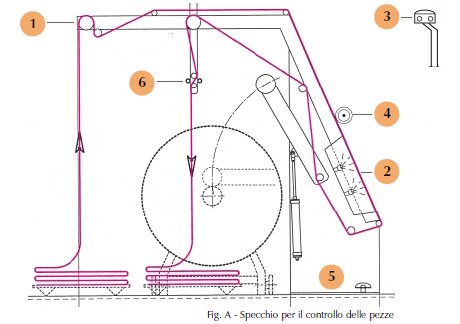© 2024 All rights reserved
Project by UsedTextilemachines.eu
Do you already have an account? Go to login Click here
Do you already have an account? Go to login Click here
Looking for the best opportunities to satisfy the customer:
Mobile Phone: +393319020189
Working hours: 09.30 / 12.30 - 16.00 / 18.00 From Monday to Friday.
The control of the pieces (raw, dyed and finished) is carried out in the mirror or court.
This machine puts the operator in the best conditions to detect and report any
defects detectable by eye.

The fabric passes:
on top of a roller (see figure A, point 1);
on the inclined plane, equipped in the center with a frosted glass window (fig. A, 2) under which
a light source favors the control in transparency;
another light source (fig. A, 3) is present at the top of the front of the machine.
The drive and control devices:
on the right side there are switches and speed variators;
on the inclined plane there is a meter-counter device (fig. A, 4);
the advancement of the fabric is regulated by a pedal control (fig. A, 5).
The checked piece is again folded (fig. A, 6), rolled up (fig. A, 7) or placed on a trestle.
Types of checks to be carried out on the dyed patches:
sample color control;
control of color uniformity
a) between the center of the piece and the selvedge,
b) between the beginning and the end of the piece;
control of the uniformity of the color with particular attention to streaks or beatings;
presence of stains (of color, of grease, of acid residues, of foreign substances, etc.);
presence of points not covered;
crow's feet (for synthetic fabrics);
level of color equalization in relation to the various qualitative components of the fabric
(melangiatura);
defects (dead folds, beatings, etc.) deriving from incorrectly carried out loading;
halos due to concentrations of coloring matter.
Dye defects can depend on:
Altered material.
The material can be polluted by degraded fibers (this is especially true for wool) which they absorb
the coloring matter in an irregular way, creating stains, halos, melanges on the fabric,
etc.
Operations prior to dyeing poorly carried out.
If the washing has left residues of soaps, oils or fats in the fabric, or if it has been charred in the fabric
excessive or uneven acidification that has changed the affinity of the fibers to the dye.
Poorly carried out dyeing process.
Here the series of defects and causes varies considerably according to the quality of the
fibers and the dyeing processes used, for which a specific discussion is referred to the relative cards
to the latter.
Irregular drying process.
- cross-sections due to machine stops (accidental and / or due to seams
patches);
- "ball" footprints due to incorrect wind regulation;
- telescope lines (the device that regulates the distance of the chains in the branches);
- more or less uniform yellowing (more frequent on very light woolen pieces or whitened patches
optically).
After the sale of the machinery we also assist you in logistics and if desired by the customer we have technicians capable of reassembling and starting the machinery.
© 2024 All rights reserved
Project by UsedTextilemachines.eu
| Cookie | Duration | Description |
|---|---|---|
| cookielawinfo-checkbox-analytics | 11 months | This cookie is set by GDPR Cookie Consent plugin. The cookie is used to store the user consent for the cookies in the category "Analytics". |
| cookielawinfo-checkbox-functional | 11 months | The cookie is set by GDPR cookie consent to record the user consent for the cookies in the category "Functional". |
| cookielawinfo-checkbox-necessary | 11 months | This cookie is set by GDPR Cookie Consent plugin. The cookies is used to store the user consent for the cookies in the category "Necessary". |
| cookielawinfo-checkbox-others | 11 months | This cookie is set by GDPR Cookie Consent plugin. The cookie is used to store the user consent for the cookies in the category "Other. |
| cookielawinfo-checkbox-performance | 11 months | This cookie is set by GDPR Cookie Consent plugin. The cookie is used to store the user consent for the cookies in the category "Performance". |
| viewed_cookie_policy | 11 months | The cookie is set by the GDPR Cookie Consent plugin and is used to store whether or not user has consented to the use of cookies. It does not store any personal data. |
Fill out the form to contact me